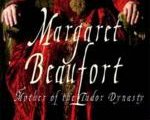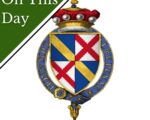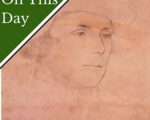This week in history events for 6th to 12th October.
[Read More...]YOUR SEARCH UNCOVERED 362 RESULTS
-
This Week in History 6 – 12 October
-
Tudor Pets Video
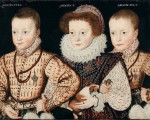
In this week’s Claire Chats video I talk about some of the pets the Tudors were known to have.
[Read More...] -
Tudor Personality Books
-
#OTD in Tudor history – 19 April

On this day in Tudor history, 19th April, Mary, Queen of Scots got betrothed to the Dauphin; Sir Francis Drake “singed the King of Spain’s beard”; and a Catholic bookseller was hanged at Tyburn…
[Read More...] -
#OTD in Tudor history – 9 April

On this day in Tudor history, 9th April, Catherine of Aragon found out that she’d been demoted to Dowager Princess of Wales; Cardinal Pole’s legatine powers were revoked; and Catherine Willoughby’s second husband, Richard Bertie, died…
[Read More...] -
#OTD in Tudor history – 10 March

On this day in Tudor history, 10th March, John de Vere, 13th Earl of Oxford and a man who commanded Henry Tudor’s archers at the Battle of Bosworth, died; Henry VIII suffered a jousting accident jousting against his friend, Charles Brandon; and William Paulet, 1st Marquess of Winchester and a man who served Henry VIII, Edward VI, Mary I and Elizabeth I, died…
[Read More...] -
An evening with Alison Weir in East Grinstead
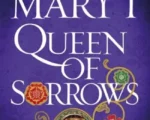
Join The East Grinstead Bookshop for an evening with Alison Weir – from the comfort of your own sitting room – to celebrate the launch of ‘Mary I, Queen of Sorrows’ : A novel by Alison Weir.
The East Grinstead Bookshop are very excited to announce the national launch of Dr Alison Weir’s new historical novel, Mary I, Queen of Sorrows, on Thursday 9 May, 7pm which be available as an on-line event, broadcast across the world. The event will be live-streamed from the historic Sackville College Almshouse, built in 1609 to solve the homeless problem in East Grinstead and still in use as an almshouse today.
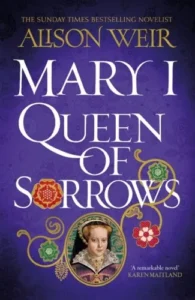 Dr Alison Weir is the bestselling female historian in the UK, with over three million copies of her fiction and non-fiction works sold to date. Even as a young girl Alison was fascinated by the Tudors, and has spent most of her life researching and writing about this period. This, her latest novel, is the third in the Tudor Rose series which fictionalises the lives of Elizabeth of York, Henry VIII and now Mary I.
Dr Alison Weir is the bestselling female historian in the UK, with over three million copies of her fiction and non-fiction works sold to date. Even as a young girl Alison was fascinated by the Tudors, and has spent most of her life researching and writing about this period. This, her latest novel, is the third in the Tudor Rose series which fictionalises the lives of Elizabeth of York, Henry VIII and now Mary I.Mary was the daughter of Katherine of Aragon and Henry VIII, a precocious young child with an able intellect and a talent for the harpsichord. Yet, as the first Queen Regnant of England she became a notorious terror, responsible for the deaths of hundreds of protestants and earning the accolade ‘Bloody Mary’. What happened?
Independent Bookseller John Pye will be in conversation with Alison for an evening of lively debate and storytelling, looking at the life of Mary and celebrating the launch of ‘Queen of Sorrows’.
“An exquisitely drawn, poignant portrayal of one of history’s most complex, maligned and fascinating figures. Told with all of Alison Weir's characteristic verve and eye for evocative period detail, this is a book that will stay with you long after the last page has been turned. A must for Tudor fans everywhere.” (Author and Historian, Tracy Borman)
Tickets may be purchased from https://www.eastgrinsteadbookshop.co.uk/event-details/alison-weir-in-conversation-with-john-pye-book-launch
-
#OTD in Tudor history – 23 February
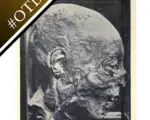
On this day in Tudor history, 23rd February, Elizabeth of York, wife of Henry VII and mother of Henry VIII, was buried at Westminster Abbey, Henry Grey, Duke of Suffolk, was executed on Tower Hill following the failed Wyatt’s Rebellion, and religious pamphleteer Job Throckmorton was buried…
[Read More...] -
#OTD in Tudor history – 21 February

On this day in Tudor history, 21st February, Pope Julius II died; Katherine Seymour (née Grey), Countess of Hertford, was buried; Ambrose Dudley, 3rd Earl of Warwick, died, and Jesuit priest Robert Southwell was hanged, drawn and quartered…
[Read More...] -
#OTD in Tudor History – 9 February
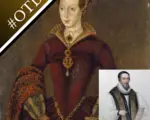
On this day in Tudor history, 9th February, Jane Boleyn, Lady Rochford, was taken to the Tower of London, Lady Jane Grey’s execution was postponed, and a prominent bishop was burnt at the stake for heresy…
[Read More...] -
#OTD in Tudor history – 6 January
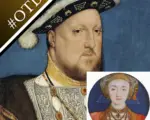
What happened on this day in history, 6th January, in the Tudor period?
Here are some event from 6th January in the reigns of the Tudor monarchs…
[Read More...] -
August 23 – Stephen Gardiner becomes Lord Chancellor
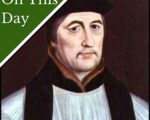
On this day in Tudor history, 23rd August 1553, just over a month after Mary I had been proclaimed queen, Stephen Gardiner, Bishop of Winchester, was made Lord Chancellor.
Here are some facts about Stephen Gardiner, a man known as “Wily Winchester”…
[Read More...] -
Catherine of Aragon – The Case for Non-consummation by Amanda Glover
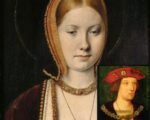
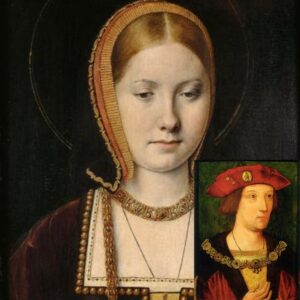 Thank you to Amanda Glover for writing this guest article for us on the question of whether Catherine of Aragon's marriage to Arthur Tudor, Prince of Wales, was consummated.
Thank you to Amanda Glover for writing this guest article for us on the question of whether Catherine of Aragon's marriage to Arthur Tudor, Prince of Wales, was consummated.The story
More than 500 years ago two teenagers married. Only four and a half months later the boy sadly died. Since then, historians have hotly debated whether the marriage was ever consummated.
The girl was called Catalina, known in England as Catherine of Aragon, and the boy was Arthur, Prince of Wales, heir to the fledgling dynasty of the Tudors.
But why was the question of the consummation so important?
When Arthur died so tragically young, his ten-year-old brother, Henry became the heir to his father’s crown. In 1509, eight years after Arthur’s demise, the 17-year-old Henry ascended the throne as Henry VIII on the death of his father, Henry VII. One of his first acts was to marry Catherine, having obtained Papal dispensation, a necessity in the eyes of the Church because of Catherine’s first marriage to Arthur, which made the new couple “related”.
-
Monday Martyr – Lollard Thomas Harding
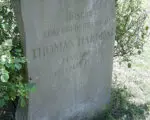
This week’s Monday Martyr is Lollard Thomas Harding.
Harding was in his sixties when he was sent to be burnt at the stake for heresy at Chesham, in Buckinghamshire, on 30th May 1532, in the reign of King Henry VIII. Thankfully, his suffering was cut short when he was killed by a blow to the head when a bystander threw a billet of wood at him.
[Read More...] -
May 3 – Cecily Neville, mother of two kings

On this day in history, 3rd May 1415, Cecily Neville, Duchess of York, was born on 3rd May 1415 at Raby Castle. Cecily is known as the matriarch of the House of York because her children included King Edward IV and King Richard III.
Here are some facts about Cecily Neville, also known as the Rose of Raby and Proud Cis.
[Read More...] -
April 30 – Sir John Puckering
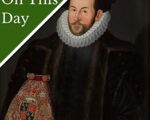
On this day in Tudor history, 30th April 1596, Elizabethan lawyer, administrator and Speaker of the House of Commons, Sir John Puckering, died from apoplexy, a stroke, at the age of fifty-two. He was buried at Westminster Abbey in St Paul’s Chapel.
[Read More...] -
March 27 – George Talbot, 4th Earl of Shrewsbury
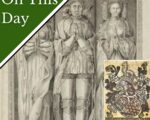
On 27th March 1539, George Talbot, 4th Earl of Shrewsbury, was laid to rest in the Shrewsbury Chapel of St Peter’s Church, Sheffield.
Talbot is known for his loyalty to the king during the Pilgrimage of Grace uprisings, which was seen as crucial to the failure of the rebellion.
But let me tell you a bit more about this Tudor earl…
[Read More...] -
March 15 – Bishop John Hooper is deprived of his bishopric

On 15th March 1554, in the reign of Queen Mary I, John Hooper, Bishop of Gloucester and Worcester, was deprived of his bishopric while imprisoned in Fleet Prison. He had been charged with owing over five hundred pounds in unpaid first fruits, a charge he denied.
Let me tell you a bit more about this man, who ended up being a Marian martyr…
[Read More...] -
March 6 – Lord Chancellor Thomas Wriothesley is accused of abusing his authority

On this day in Tudor history, 6th March 1547, in the reign of King Edward VI, former Lord Chancellor to Henry VIII, Thomas Wriothesley, 1st Earl of Southampton, lost the Great Seal of his Lord Chancellorship and was confined to his home at Ely Place for abusing his authority.
Wriothesley was found guilty of issuing a commission without the knowledge or permission of the other executors of Henry VIII’s will, but it was probably more to do with his opposition to Edward Seymour, Duke of Somerset, becoming Lord Protector.
[Read More...] -
March 1 – Sir Thomas Tresham, Grand Prior
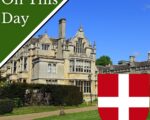
On this day in Tudor history, 1st March 1559, in the reign of Queen Elizabeth I, Catholic politician and landowner, Sir Thomas Tresham, died at Rushton in Northamptonshire. He was buried at St Peter’s Church, Rushton.
Tresham was a leading politician in the reigns of Henry VIII and Mary I, and he’s an interesting Tudor chap.
Let me tell you a bit more about him…
[Read More...] -
Interview with Toni Mount, author of The Colour of Bone, a medieval murder mystery

Thank you to author and historian Toni Mount for stopping by the Tudor Society on the book/blog tour for her new book, “The Colour of Bone”, the eleventh novel in the Seb Foxley medieval murder mystery series.
Toni has answered some interview questions…
[Read More...] -
February 28 – The death of theologian and Protestant reformer Martin Bucer
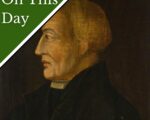
During the night of 28th February/1st March 1551, theologian and Protestant reformer Martin Bucer died in Cambridge. He was fifty-nine years old.
Let me tell tell you a bit more about this reformer, who ended up being posthumously burned as a heretic in Mary I’s reign!
[Read More...] -
February 24 – Henry Howard, Earl of Northampton, author, courtier and a man caught up in a murder

On this day in Tudor history, 24th February 1540, in the reign of King Henry VIII, courtier, author and administrator, Henry Howard, Earl of Northampton, was born at Shottesham in Norfolk.
Northampton was the second son of courtier and poet Henry Howard, Earl of Surrey, and his wife, Lady Frances de Vere.
Let me give you a few facts about this Tudor earl…
[Read More...] -
February 14 – William Berkeley, 1st Marquess of Berkeley

On this day in Tudor history, 14th February 1492, in the reign of King Henry VII, magnate William Berkeley, Marquis of Berkeley, died. He was buried in the Augustinian friary in London with his second wife, Joan.
Berkeley is known for his involvement in the 1470 Battle of Nibley Green, the last English battle fought between private armies of feudal magnates.
[Read More...] -
February 9 – A reprieve for Lady Jane Grey
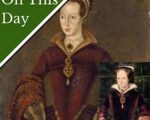
This day in Tudor history, 9th February 1554, in the reign of Queen Mary I, was one of the dates set for the execution of Lady Jane Grey, the former Queen Jane, but she was granted a three-day reprieve.
Why and what had happened between her trial in November 1553, when she had been condemned to death, and this day?
Let me tell you…
[Read More...] -
An Extract from “Tudor England: A History”
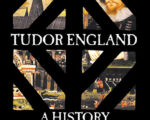
Lucy Wooding is the Langford fellow and tutor in history at Lincoln College, Oxford. She is an expert on Reformation England and its politics, religion, and culture and the author of Henry VIII. She has asked us to share this section from her book "Tudor England: A History".
You can get the book at THIS LINK
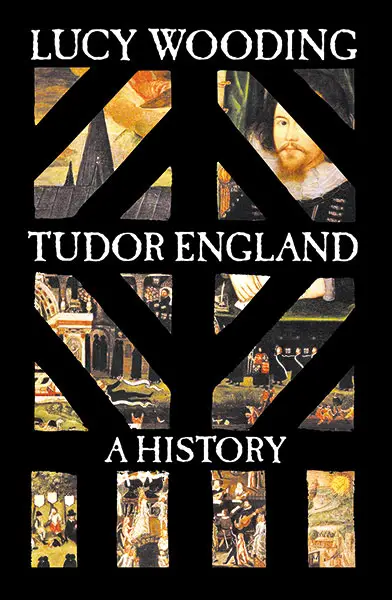 As the tensions of the later sixteenth century, both religious and political, became more acute, Tudor drama itself became more sophisticated, and more heavily freighted with meaning. Elizabethan plays might have a dangerously polemical edge, or a blunt propaganda purpose. Where fifteenth-century plays had often conveyed a religious message, later Tudor drama continued to explore moral dilemmas, albeit with a level of self-conscious wariness that earlier dramas had lacked. Solely religious plays became a thing of the past in the fraught confessional climate of the 1580s and 1590s, but drama became, if anything, more pervasive1. Plays, or ‘playings’, took place at Court, in private households, in the universities and Inns of Court, in taverns and inns, in the market square or through the streets of a city on May Day or to celebrate midsummer. By the end of the sixteenth century, there were also commercial theatrical spaces akin to the modern theatre; the first of these was built by James Burbage in Shoreditch in 1576, and called simply the Theatre2. South of the river, Philip Henslowe built the Rose on Bankside in 1587, and it was joined in 1595 by the Swan and in 1599 by the Globe. Yet even in the age of Shakespeare, theatre still belonged as much in the street or the household as upon a stage.
As the tensions of the later sixteenth century, both religious and political, became more acute, Tudor drama itself became more sophisticated, and more heavily freighted with meaning. Elizabethan plays might have a dangerously polemical edge, or a blunt propaganda purpose. Where fifteenth-century plays had often conveyed a religious message, later Tudor drama continued to explore moral dilemmas, albeit with a level of self-conscious wariness that earlier dramas had lacked. Solely religious plays became a thing of the past in the fraught confessional climate of the 1580s and 1590s, but drama became, if anything, more pervasive1. Plays, or ‘playings’, took place at Court, in private households, in the universities and Inns of Court, in taverns and inns, in the market square or through the streets of a city on May Day or to celebrate midsummer. By the end of the sixteenth century, there were also commercial theatrical spaces akin to the modern theatre; the first of these was built by James Burbage in Shoreditch in 1576, and called simply the Theatre2. South of the river, Philip Henslowe built the Rose on Bankside in 1587, and it was joined in 1595 by the Swan and in 1599 by the Globe. Yet even in the age of Shakespeare, theatre still belonged as much in the street or the household as upon a stage.Drama was not just a source of entertainment or moral commentary: it was proactive in the shaping of affairs and attitudes. In an age when institutions were still flimsy, and politics were intensely personal, power could be confirmed or qualified through magnificence and display. The commonwealth, or state, was something imagined, but still it elicited an emotional investment given immediacy through symbolism3. Each display of power required a response, and each enactment of authority called for an answer, so drama was also a site for negotiation and the exchange of ideas in this ‘theatre state’4. Royal processions, progresses and tournaments encapsulated important transactions between ruler and ruled; in council meetings, parliaments and royal audiences, confrontations were enacted in which policy was shaped by participants on both sides. Deaths on the scaffold required the speeches of those about to die to reinforce codes of honour and obedience, while subtle alterations to the formulaic expressions of penitence and obedience might equally convey protestations of innocence, or even defiance. The drive for religious conformity made martyrs of many whose extraordinary commitment led them willingly to play their parts in a terrible drama of death. In their sufferings could be seen either the moral might of a government staunchly opposing heresy, or conversely, a testimony to religious truth serving as a powerful reproach to a persecutory regime; it was for the audience to choose.
This was an age in which men and women often found it easiest to express their own identity by acting a part. Elizabeth I in her lifetime was cast by both herself and others in roles as various as the Old Testament heroine Deborah or the goddess Diana; as the mythical King Arthur or the historical Emperor Constantine. When she famously remarked to William Lambarde, keeper of the Tower, ‘know ye not I am Richard II?’, she was acknowledging her own questionable reputation as ruler in her twilight years; she was also signalling the broader principle that political meaning could be readily conveyed by mimesis5. Badgered by parliament to execute Mary Queen of Scots, she reminded them of the dangers of public scrutiny: ‘Princes, you know, stand upon stages so that their actions are viewed and beheld of all men; and I am sure my doings will come to the scanning of many fine wits, not only within the realm, but in foreign countries.’6 Henry VII, in just a single royal progress in 1486, had been variously depicted as Solomon, Noah, Jason, Isaac, Jacob, David, Scipio and Arthur – legendary figures, invoked at a time of dangerous political instability, when the sanction of past rulers, generals and prophets was badly needed.7
References
- Thomas Betteridge and Greg Walker, ‘Introduction’, in Thomas Betteridge and Greg Walker (eds), The Oxford Handbook of Tudor Drama (Oxford, 2012), 4–8, 11.
- William Ingram, The Business of Playing: The beginnings of the adult professional theater in Elizabethan England (Ithaca, NY, 1992).
- Michael Walzer, ‘On the role of symbolism in political thought’, Political Science Quarterly 82 (1987), 194–95.
- For the conception of the ‘theatre state’, see Clifford Geertz, Negara: The theatre state in nineteenth-century Bali (Princeton, NJ, 1980), also Clifford Geertz, ‘Centers, kings and charisma: Reflections on the symbolics of power’, in Joseph Ben-David and Terry Nicholas Clark (eds), Culture and Its Creators: Essays in Honor of Edward Shils (Chicago, IL, 1977), and Clifford Geertz, ‘Politics past, politics present’, in Clifford Geertz, The Interpretation of Cultures: Selected essays (second edition, New York, 2000), 327–41.
- Stephen Orgel, Spectacular Performances: Essays on theatre, imagery, books and selves in early modern England (Manchester, 2011), 7–35.
- Elizabeth I: Collected Works, 189.
- David Bevington, Tudor Drama and Politics (Cambridge, MA, 1968), 6; see also John C. Meagher, ‘The first progress of Henry VII’, Renaissance Drama 1 (1968), 45–73.
-
February 1 – Alchemist Roger Cooke
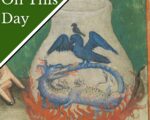
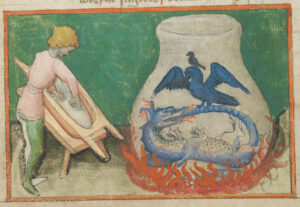 On this day in Tudor history, 1st February 1552, in the reign of King Edward VI, alchemist Roger Cooke was born.
On this day in Tudor history, 1st February 1552, in the reign of King Edward VI, alchemist Roger Cooke was born.Here are some facts about this Tudor alchemist who started his career in the household of Dr John Dee and also worked for Henry Percy, 9th Earl of Northumberland, and Sir Walter Ralegh...
- Cooke’s beginnings are obscure, but in 1567, when he was fourteen years of age, he joined the household of Dr John Dee and became his assistant.
- Cooke helped Dee with his experiments in alchemy and may also have practised scrying, that is to say, using a reflective surface or a crystal for divination.
- In his diary entry for 28th December 1579, Dee recorded “I reveled to Roger Cokeo the gret secret of the elixir of the salt, an alchemical secret”, which is thought to be alchemical projection with salts of metals. Dee obviously trusted Cooke, and they had a good relationship. However, in 1581 the relationship came to an abrupt end. In his diary entry for 5th September, Dee records what happened:
“Sept. 5th, Roger Cook, who had byn with me from his 14 yeres of age till 28, of a melancholik nature, pycking and devising occasions of just cause to depart on the suddayn, abowt 4 of the clok in the afternone requested of me lycense to depart, wheruppon rose whott words between us; and he, imagining with hisself that he had the 12 of July deserved my great displeasure and finding himself barred from vew of my philosophicall dealing with Mr. Henrik, thowght that he was utterly recest from intended goodnes toward him. Notwithstanding Roger Cook his unseamely dealing, I promised him, yf he used himself toward me now in his absens, one hundred poundst as sone as of my own clene hability I myght spare so much; and moreover, if he used himself well in lif toward God and the world, I promised him some pretty alchimicall experiments, whereuppon he might honestly live.”
However, two days later, Dee recorded “Sept. 7th, Roger Cook went for alltogether from me”, and on 29th September, Dee replaced him with Robert Gardner, of Shrewsbury”. - We don’t know what Cooke did next, but fastforward to 1600, when Cooke was 48, and he is mentioned again in Dee’s diary. Dee records: “Sept. 30th, after the departing of Mr. Francis Nicolls, his dowghter Mistres Mary, his brother Mr. William, Mr. Wortley, at my returne from Deansgate, to the ende whereof I browght them on fote, Mr. Roger Kooke offred and promised his faithfull and diligent care and help, to the best of his skill and powre, in the processes chymicall, and that he will rather do so then to be with any in England; which his promise the Lord blesse and confirm! He told me that Mr. Anthony considered him very liberally and frendely, but he told him that he had promised me. Then he liked in him the fidelity of regarding such his promise.”
The Mr Anthony that is mentioned must be the physician and alchemist who went on to sell his secret remedy, "Aurum Potabile”, or drinkable gold. I did a video on him so I’ll give you a link to that. It seems that Cooke was going to work for Anthony, or had been working for him, but excused himself as promised to Dee. In a later diary entry, Dee recorded that Cooke began to distill on 1st - Just three months later, on 2nd February 1601, Dee recorded that his son, Arthur, had found Cooke going through a box of Arthur’s papers. Suspecting Cooke of plotting against his father, Arthur took Cooke before Dee. Fortunately, Dee was able to record in his diary “All was mistaken, and we reconcyled godly”. Dee goes on to write that the two were reconciled and that he explained all to his wife and sons. There’s an interesting entry in Dee’s diary just over three weeks later, on 25th February, when Dee records “R. Koke pactum sacrum hora octave mane”, meaning sacred pact 8 o’clock in the morning” with no other details and then the next entry is “March 2nd, Mr Roger Coke went toward London”. Perhaps the pact was regarding Cooke leaving Dee’s service, but promising to keep his work secret. We don’t know.
- Historian Lauren Kassell notes that a Roger Cooke was employed by Henry Percy, 9th Earl of Northumberland and Sir Walter Ralegh to build and run a still house at the Tower of London between 1606 and around 1609. Northumberland was known as the Wizard Earl due to his experiments in alchemy and science, and he and Ralegh were prisoners in the Tower at the time. Ralegh was able to persuade the Lieutenant of the Tower to let them convert a hen house into a still house. Charles Webster, author of “Health, Medicine and Mortality in the 16th Century”, writes that Ralegh then studied the chemistry of metals and “prepared his celebrated cordials” and other medicines.
- Cooke is also linked to Cornelis Drebbel who was working in Prague from 1610 at the invitation of Emperor Rudolf II, who was interested in alchemy. A man named Cooke assisted Drebbel with his experiments before returning to England in 1612. It is not known what happened to Cooke after his return, or when he died. He just disappears from the records.
An interesting man!
Image: Image from a 15th century alchemical treatise, Aurora consurgens
-
January 22 – Francis Bacon, Viscount St Alban

On this day in Tudor history, 22nd January 1561, Francis Bacon, Viscount St Alban, was born at York House in the Strand, London.
[Read More...]

